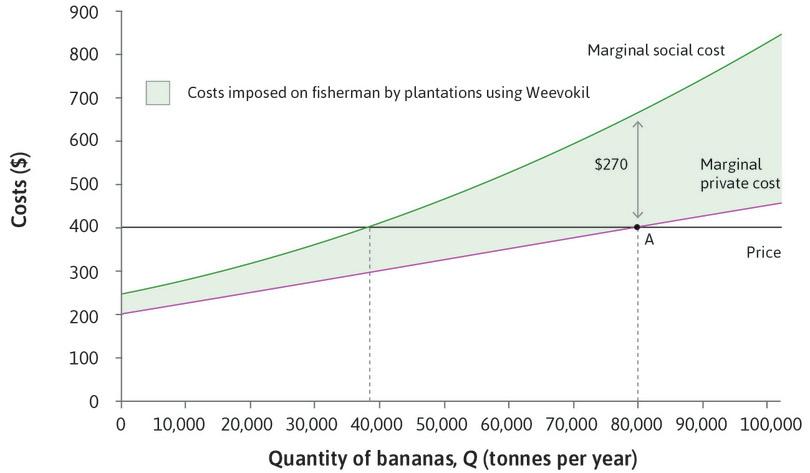Leibniz
12.1.1 External effects of pollution
When the production or consumption of a good affects anyone other than the buyers and sellers, the market allocation of the good will not be Pareto efficient. We demonstrate this mathematically in the case of banana production using a pesticide, Weevokil, which pollutes the waters of neighbouring fishermen. The quantity of bananas produced and sold is greater than the Pareto-efficient level.
- Pareto efficient
- An allocation with the property that there is no alternative technically feasible allocation in which at least one person would be better off, and nobody worse off.
In Leibniz 8.5.1, we analysed the gains from trade in the bread market by calculating the total surplus, which was equal to the sum of the consumer surplus and the producer surplus. We showed that the allocation of a market equilibrium in perfect competition maximized the total surplus. It follows that, at this allocation, it is not possible to make any of the consumers or firms better off (that is, to increase the surplus of any individual) without making at least another one of them worse off. Assuming that what happens in this market does not affect anyone other than the participating buyers and sellers, we can say that the equilibrium allocation is Pareto efficient.
To analyse the case of banana production on the Caribbean island where Weevokil is used, we adopt the same approach, working out the total surplus resulting from the production and sale of bananas. But there is an important difference. Banana production affects the buyers and sellers of bananas, but also it has a negative external effect on fishermen—the cost of water pollution from the pesticide. So when we calculate the total surplus, we need to include the fishermen’s costs too.
There is another difference between the bread market model and the banana production model. We assume that however many bananas are produced on the island, they can be sold in the world wholesale banana market at a constant price, . This is a reasonable assumption as long as the island only produces a small fraction of the world’s bananas. It means that decisions about banana production on the island do not change the surplus obtained by consumers, whether they live on the island, or elsewhere in the world. So we don’t need to include consumer surplus in our analysis. Note that this assumption is a useful simplification, but it would be straightforward to adapt the model to the case where the island was a large banana producer.
Overall, then, the total surplus (often called the social surplus in this context) from growing bananas will be the sum of the producer surplus and the surplus obtained by fishermen. But since the effect on the fishermen is negative, we write the social surplus as:
The producer surplus is calculated just as in Leibniz 8.5.1. It is equal to the banana growers’ revenue, minus their total cost of production. If tonnes of bananas are produced and sold, producer surplus is:
Here, is the total private cost of producing bananas. In economic terminology, the private costs and benefits of a decision are costs and benefits experienced by the decision-maker. Let be the external cost imposed on the fishermen when tonnes of bananas are produced. We can say that the social cost of banana production is , the sum of the private and external costs.
The social surplus is then:
The derivatives of the three cost functions, , and , denote marginal social cost (MSC), marginal private cost (MPC), and marginal external cost (MEC), respectively. We assume that for all , which means that MEC is positive, and that MSC and MPC are increasing in output. Thus and are convex functions.
Hence is a concave function, and the social surplus is maximized at the level of output which satisfies the first-order condition . Differentiating the expression above for , we find that is the output level at which the marginal social cost of bananas is equal to the price:
Since the social surplus is maximized at we know that if a different level of output were chosen, for example to make the fishermen better off (by lowering their costs), then it must make the plantations worse off. So is the Pareto-efficient level of output.
However, is not the level of output that will be produced in equilibrium. The banana plantations are profit-maximizing firms and they are price-takers, because whatever the quantity of bananas they produce, the price at which each tonne of bananas can be sold is . So they each choose their output so that their marginal private cost is equal to the market price, and the market supply curve is therefore the marginal private cost curve. Thus the total output of the plantations satisfies the equation:
To compare the private equilibrium level of output with the Pareto efficient level , consider the derivative of the social surplus:
Since MEC is positive, it follows that:
And since is a concave function ( falls as increases), we deduce that:
This inequality tells us that the banana growers produce too much output, according to the criterion of Pareto efficiency. This result can be seen in Figure 12.2 of the text, reproduced as Figure 1 below. In the figure, you can see the features of the problem we have analysed mathematically above:
- The marginal social cost , and the marginal private cost , increase with output.
- The marginal social cost is greater than the marginal private cost, and the difference is the marginal external cost.
- The Pareto-efficient level of output is where the marginal social cost is equal to the price. In the diagram, , and .
- The plantations will produce , where the marginal private cost is equal to the price. In the diagram ; they produce more than the Pareto-efficient level.

